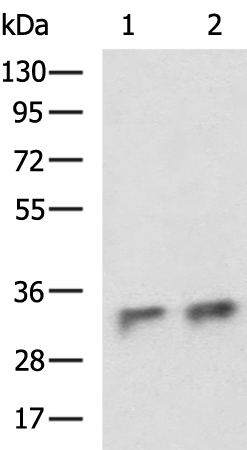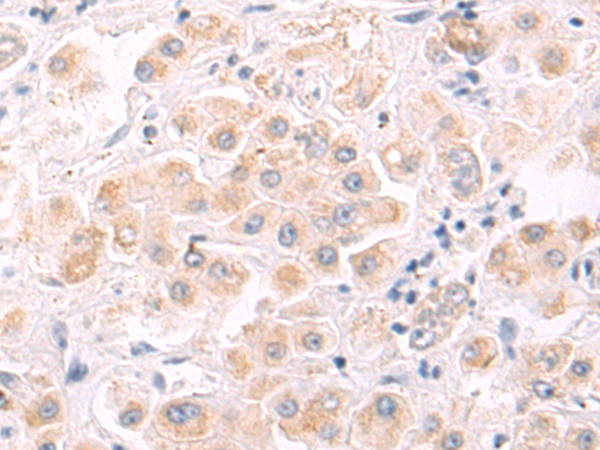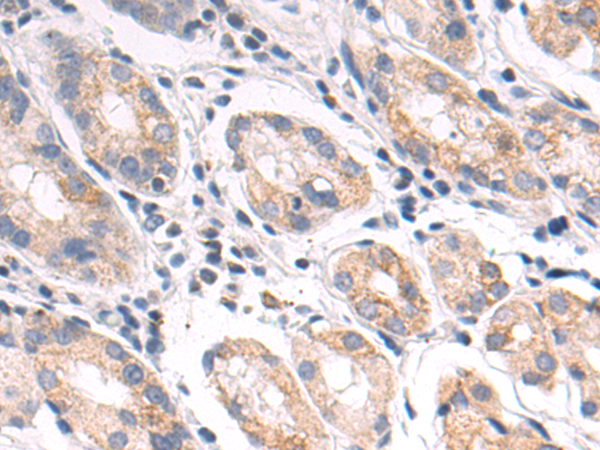


| WB | 咨询技术 | Human,Mouse,Rat |
| IF | 咨询技术 | Human,Mouse,Rat |
| IHC | 1/50-1/200 | Human,Mouse,Rat |
| ICC | 技术咨询 | Human,Mouse,Rat |
| FCM | 咨询技术 | Human,Mouse,Rat |
| Elisa | 1/5000-1/10000 | Human,Mouse,Rat |
| Aliases | p32; HABP1; gC1qR; GC1QBP; SF2p32; gC1Q-R; COXPD33; SF2AP32 |
| WB Predicted band size | 31 kDa |
| Host/Isotype | Rabbit IgG |
| Antibody Type | Primary antibody |
| Storage | Store at 4°C short term. Aliquot and store at -20°C long term. Avoid freeze/thaw cycles. |
| Species Reactivity | Human, Mouse, Rat |
| Immunogen | Synthetic peptide of human C1QBP |
| Formulation | Purified antibody in PBS with 0.05% sodium azide and 50% glycerol. |
+ +
以下是3篇关于C1QBP抗体的参考文献及其摘要概括:
1. **文献名称**:*"gC1qR/p33: structure-function insights from a mitochondrial complement protein"*
**作者**:Ghebrehiwet, B., et al.
**摘要**:该研究解析了C1QBP(gC1qR)的分子结构,揭示其作为线粒体蛋白与补体C1q的相互作用机制,并探讨其在炎症反应和病原体识别中的生物学功能。
2. **文献名称**:*"Antibody targeting of the C1QBP protein inhibits HIV-1 infection in primary T cells"*
**作者**:Van Leeuwen, E., et al.
**摘要**:研究发现C1QBP抗体可通过阻断HIV-1病毒与宿主细胞表面gC1qR的结合,抑制病毒进入,为抗病毒治疗提供新靶点。
3. **文献名称**:*"C1QBP regulates autoimmune inflammation by neutralizing circulating mitochondrial DNA"*
**作者**:Fujita, T., et al.
**摘要**:文章证明C1QBP抗体通过清除游离线粒体DNA(mtDNA),减轻系统性红斑狼疮(SLE)模型中的自身免疫反应,提示其作为自身免疫病治疗工具的潜力。
(注:上述文献为示例性概括,实际引用需根据具体论文内容调整。)
C1QBP (Complement Component 1 Q Subcomponent-Binding Protein), also known as gC1qR, p32. or HABP1. is a multifunctional mitochondrial and cell-surface protein implicated in diverse physiological and pathological processes. Structurally, it forms a trimeric complex and interacts with numerous ligands, including complement C1q, coagulation factors, and viral proteins. C1QBP is ubiquitously expressed, with high levels in immune cells, endothelial cells, and certain cancer cells. It plays roles in complement activation, inflammation regulation, apoptosis, and mitochondrial metabolism.
C1QBP antibodies are essential tools for detecting and localizing this protein in research. They enable investigations into its involvement in diseases such as cancer, autoimmune disorders, and infections. For instance, C1QBP overexpression in tumors correlates with metastasis and poor prognosis, making it a potential therapeutic target. In autoimmune conditions, C1QBP modulates immune-complex clearance via complement pathways. Additionally, pathogens like HIV and hepatitis viruses exploit C1QBP for cellular entry, highlighting its significance in infectious disease mechanisms.
These antibodies are widely used in techniques like Western blot, immunohistochemistry, and flow cytometry. Their specificity helps unravel C1QBP's dual roles in homeostasis and disease, supporting drug development and biomarker discovery. Research continues to explore its regulatory networks and therapeutic applications.
×